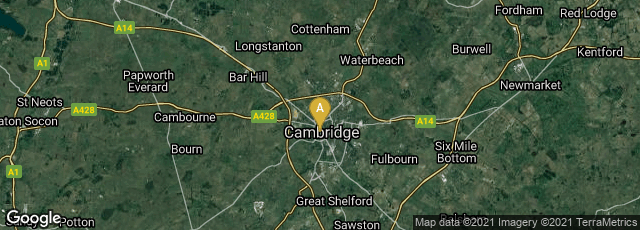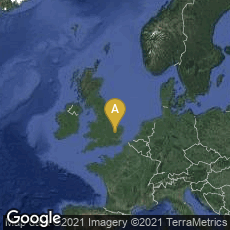

A: Cambridge, England, United Kingdom
In March 1943 quantum physicist and theoretical biologist Erwin Schrödinger delivered a series of lectures at Trinity College Dublin entitled What is Life? The Physical Aspect of the Living Cell. These lectures popularized ideas about the physical basis of biological phenomena developed by Max Delbrück and N. V. Timofeev-Ressovsky in a paper they published in 1935. Even during wartime in England Schrödinger's lectures gained enough publicity to be reported on in the April 5, 1943 issue of Time magazine. The lectures were published as a small book in 1944 by Cambridge University Press. In this form they profoundly influenced James D. Watson and others, such as Francis Crick, whose background was in physics.
Watson wrote: "From the moment I read Schrödinger's What is Life I became polarized toward finding out the secret of the gene" (Watson in Cairns, Phage and the Origins of Molecular Biology, 239).
In his autobiography molecular biologist Sydney Brenner pointed out a fundamental mistake in Schrödinger’s understanding of how genes would operate:
“Anyway, the key point is that Schrödinger says that the chromosomes contain the information to specify the future organism and the means to execute it. I have come to call this ‘Schrödinger’s fundamental error.’ In describing the structure of the chromosome fibre as a code script he states that. ‘The chromosome structures are at the same time instrumental in bringing about the development they foreshadow. They are code law and executive power, or to use another simile, they are the architect’s plan and the builder’s craft in one.’ [Schrödinger, p. 20,]. What Schrödinger is saying here is that the chromosomes not only contain a description of the future organism, but also the means to implement the description, or program, as we might call it. And that is wrong! The chromosomes contain the information to specify the future organism and a description of the means to implement this, but not the means themselves. This logical difference was made crystal clear to me when I read the von Neumann article [Hixon Symposium, 1948] because he very clearly distinguishes between the things that read the program and the program itself. In other words, the program has to build the machinery to execute itself” (Brenner, My Life in Science [2001] 33-34).